HLTH7004: Palliative Care - Quality of Life, Legal and Ethical Aspects
VerifiedAdded on 2023/06/18
|10
|3183
|326
Essay
AI Summary
This essay provides an in-depth analysis of palliative care, focusing on the multifaceted aspects of quality of life and dying. It begins with a personal reflection on factors influencing quality of life, such as the natural environment, economic security, social interaction, education, health, and material living conditions. The essay then explores domains contributing to the quality of dying, including family support, the moment of death, and preparation for death. Further exploration delves into legal aspects like euthanasia, advance care planning, and refusal of medical treatment, alongside cultural and religious influences on perceptions of living and dying, drawing examples from Arab, Philippine, Maori cultures, and Christianity. The essay highlights the complexities involved in palliative care and the importance of considering various factors to ensure a dignified and comfortable end-of-life experience.

ESSAY: PALLIATIVE CARE
Paraphrase This Document
Need a fresh take? Get an instant paraphrase of this document with our AI Paraphraser

Table of Contents
INTRODUCTION...........................................................................................................................3
MAIN BODY...................................................................................................................................3
PART 1: REFLECTION .................................................................................................................3
Factors that affect the concept of quality of life.....................................................................3
Domains contributing to quality of dying..............................................................................4
Reflection to the quality of life and dying..............................................................................5
PART 2: EXPLORATION .............................................................................................................6
Legal aspects..........................................................................................................................6
Cultural factors impacting the concept of living and dying...................................................7
Religious approach to the concept of living and dying..........................................................7
CONCLUSION................................................................................................................................8
REFERENCES................................................................................................................................9
INTRODUCTION...........................................................................................................................3
MAIN BODY...................................................................................................................................3
PART 1: REFLECTION .................................................................................................................3
Factors that affect the concept of quality of life.....................................................................3
Domains contributing to quality of dying..............................................................................4
Reflection to the quality of life and dying..............................................................................5
PART 2: EXPLORATION .............................................................................................................6
Legal aspects..........................................................................................................................6
Cultural factors impacting the concept of living and dying...................................................7
Religious approach to the concept of living and dying..........................................................7
CONCLUSION................................................................................................................................8
REFERENCES................................................................................................................................9
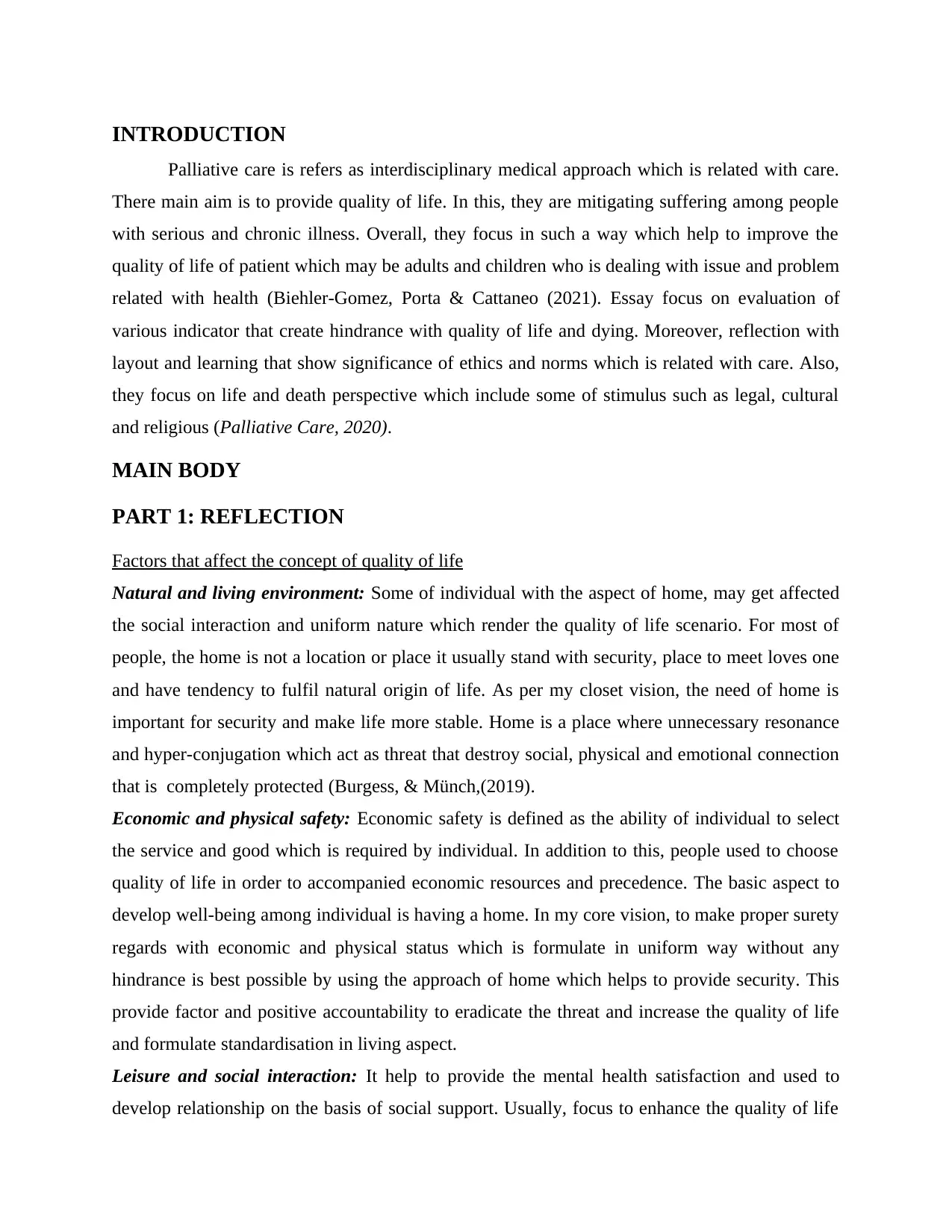
INTRODUCTION
Palliative care is refers as interdisciplinary medical approach which is related with care.
There main aim is to provide quality of life. In this, they are mitigating suffering among people
with serious and chronic illness. Overall, they focus in such a way which help to improve the
quality of life of patient which may be adults and children who is dealing with issue and problem
related with health (Biehler‐Gomez, Porta & Cattaneo (2021). Essay focus on evaluation of
various indicator that create hindrance with quality of life and dying. Moreover, reflection with
layout and learning that show significance of ethics and norms which is related with care. Also,
they focus on life and death perspective which include some of stimulus such as legal, cultural
and religious (Palliative Care, 2020).
MAIN BODY
PART 1: REFLECTION
Factors that affect the concept of quality of life
Natural and living environment: Some of individual with the aspect of home, may get affected
the social interaction and uniform nature which render the quality of life scenario. For most of
people, the home is not a location or place it usually stand with security, place to meet loves one
and have tendency to fulfil natural origin of life. As per my closet vision, the need of home is
important for security and make life more stable. Home is a place where unnecessary resonance
and hyper-conjugation which act as threat that destroy social, physical and emotional connection
that is completely protected (Burgess, & Münch,(2019).
Economic and physical safety: Economic safety is defined as the ability of individual to select
the service and good which is required by individual. In addition to this, people used to choose
quality of life in order to accompanied economic resources and precedence. The basic aspect to
develop well-being among individual is having a home. In my core vision, to make proper surety
regards with economic and physical status which is formulate in uniform way without any
hindrance is best possible by using the approach of home which helps to provide security. This
provide factor and positive accountability to eradicate the threat and increase the quality of life
and formulate standardisation in living aspect.
Leisure and social interaction: It help to provide the mental health satisfaction and used to
develop relationship on the basis of social support. Usually, focus to enhance the quality of life
Palliative care is refers as interdisciplinary medical approach which is related with care.
There main aim is to provide quality of life. In this, they are mitigating suffering among people
with serious and chronic illness. Overall, they focus in such a way which help to improve the
quality of life of patient which may be adults and children who is dealing with issue and problem
related with health (Biehler‐Gomez, Porta & Cattaneo (2021). Essay focus on evaluation of
various indicator that create hindrance with quality of life and dying. Moreover, reflection with
layout and learning that show significance of ethics and norms which is related with care. Also,
they focus on life and death perspective which include some of stimulus such as legal, cultural
and religious (Palliative Care, 2020).
MAIN BODY
PART 1: REFLECTION
Factors that affect the concept of quality of life
Natural and living environment: Some of individual with the aspect of home, may get affected
the social interaction and uniform nature which render the quality of life scenario. For most of
people, the home is not a location or place it usually stand with security, place to meet loves one
and have tendency to fulfil natural origin of life. As per my closet vision, the need of home is
important for security and make life more stable. Home is a place where unnecessary resonance
and hyper-conjugation which act as threat that destroy social, physical and emotional connection
that is completely protected (Burgess, & Münch,(2019).
Economic and physical safety: Economic safety is defined as the ability of individual to select
the service and good which is required by individual. In addition to this, people used to choose
quality of life in order to accompanied economic resources and precedence. The basic aspect to
develop well-being among individual is having a home. In my core vision, to make proper surety
regards with economic and physical status which is formulate in uniform way without any
hindrance is best possible by using the approach of home which helps to provide security. This
provide factor and positive accountability to eradicate the threat and increase the quality of life
and formulate standardisation in living aspect.
Leisure and social interaction: It help to provide the mental health satisfaction and used to
develop relationship on the basis of social support. Usually, focus to enhance the quality of life
⊘ This is a preview!⊘
Do you want full access?
Subscribe today to unlock all pages.

Trusted by 1+ million students worldwide
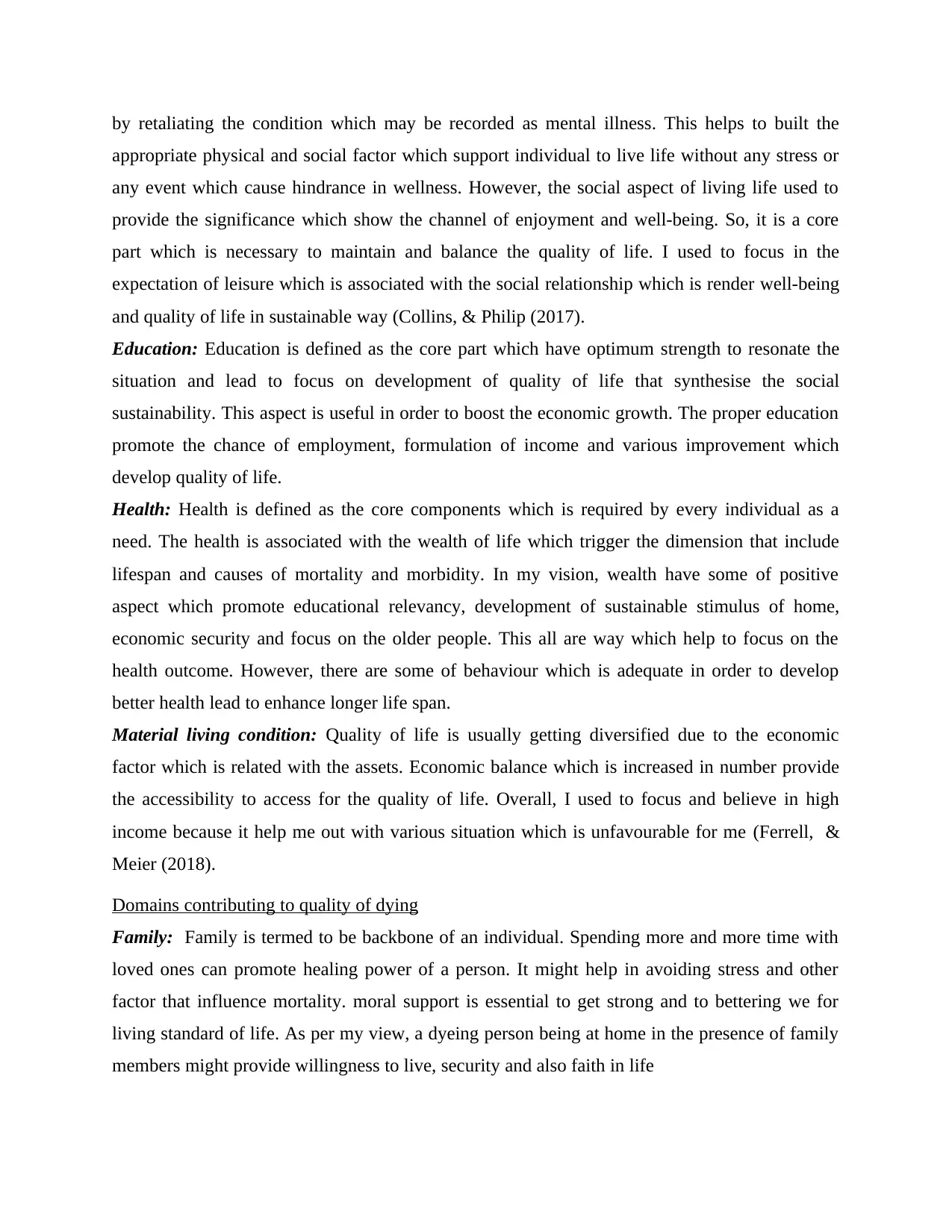
by retaliating the condition which may be recorded as mental illness. This helps to built the
appropriate physical and social factor which support individual to live life without any stress or
any event which cause hindrance in wellness. However, the social aspect of living life used to
provide the significance which show the channel of enjoyment and well-being. So, it is a core
part which is necessary to maintain and balance the quality of life. I used to focus in the
expectation of leisure which is associated with the social relationship which is render well-being
and quality of life in sustainable way (Collins, & Philip (2017).
Education: Education is defined as the core part which have optimum strength to resonate the
situation and lead to focus on development of quality of life that synthesise the social
sustainability. This aspect is useful in order to boost the economic growth. The proper education
promote the chance of employment, formulation of income and various improvement which
develop quality of life.
Health: Health is defined as the core components which is required by every individual as a
need. The health is associated with the wealth of life which trigger the dimension that include
lifespan and causes of mortality and morbidity. In my vision, wealth have some of positive
aspect which promote educational relevancy, development of sustainable stimulus of home,
economic security and focus on the older people. This all are way which help to focus on the
health outcome. However, there are some of behaviour which is adequate in order to develop
better health lead to enhance longer life span.
Material living condition: Quality of life is usually getting diversified due to the economic
factor which is related with the assets. Economic balance which is increased in number provide
the accessibility to access for the quality of life. Overall, I used to focus and believe in high
income because it help me out with various situation which is unfavourable for me (Ferrell, &
Meier (2018).
Domains contributing to quality of dying
Family: Family is termed to be backbone of an individual. Spending more and more time with
loved ones can promote healing power of a person. It might help in avoiding stress and other
factor that influence mortality. moral support is essential to get strong and to bettering we for
living standard of life. As per my view, a dyeing person being at home in the presence of family
members might provide willingness to live, security and also faith in life
appropriate physical and social factor which support individual to live life without any stress or
any event which cause hindrance in wellness. However, the social aspect of living life used to
provide the significance which show the channel of enjoyment and well-being. So, it is a core
part which is necessary to maintain and balance the quality of life. I used to focus in the
expectation of leisure which is associated with the social relationship which is render well-being
and quality of life in sustainable way (Collins, & Philip (2017).
Education: Education is defined as the core part which have optimum strength to resonate the
situation and lead to focus on development of quality of life that synthesise the social
sustainability. This aspect is useful in order to boost the economic growth. The proper education
promote the chance of employment, formulation of income and various improvement which
develop quality of life.
Health: Health is defined as the core components which is required by every individual as a
need. The health is associated with the wealth of life which trigger the dimension that include
lifespan and causes of mortality and morbidity. In my vision, wealth have some of positive
aspect which promote educational relevancy, development of sustainable stimulus of home,
economic security and focus on the older people. This all are way which help to focus on the
health outcome. However, there are some of behaviour which is adequate in order to develop
better health lead to enhance longer life span.
Material living condition: Quality of life is usually getting diversified due to the economic
factor which is related with the assets. Economic balance which is increased in number provide
the accessibility to access for the quality of life. Overall, I used to focus and believe in high
income because it help me out with various situation which is unfavourable for me (Ferrell, &
Meier (2018).
Domains contributing to quality of dying
Family: Family is termed to be backbone of an individual. Spending more and more time with
loved ones can promote healing power of a person. It might help in avoiding stress and other
factor that influence mortality. moral support is essential to get strong and to bettering we for
living standard of life. As per my view, a dyeing person being at home in the presence of family
members might provide willingness to live, security and also faith in life
Paraphrase This Document
Need a fresh take? Get an instant paraphrase of this document with our AI Paraphraser
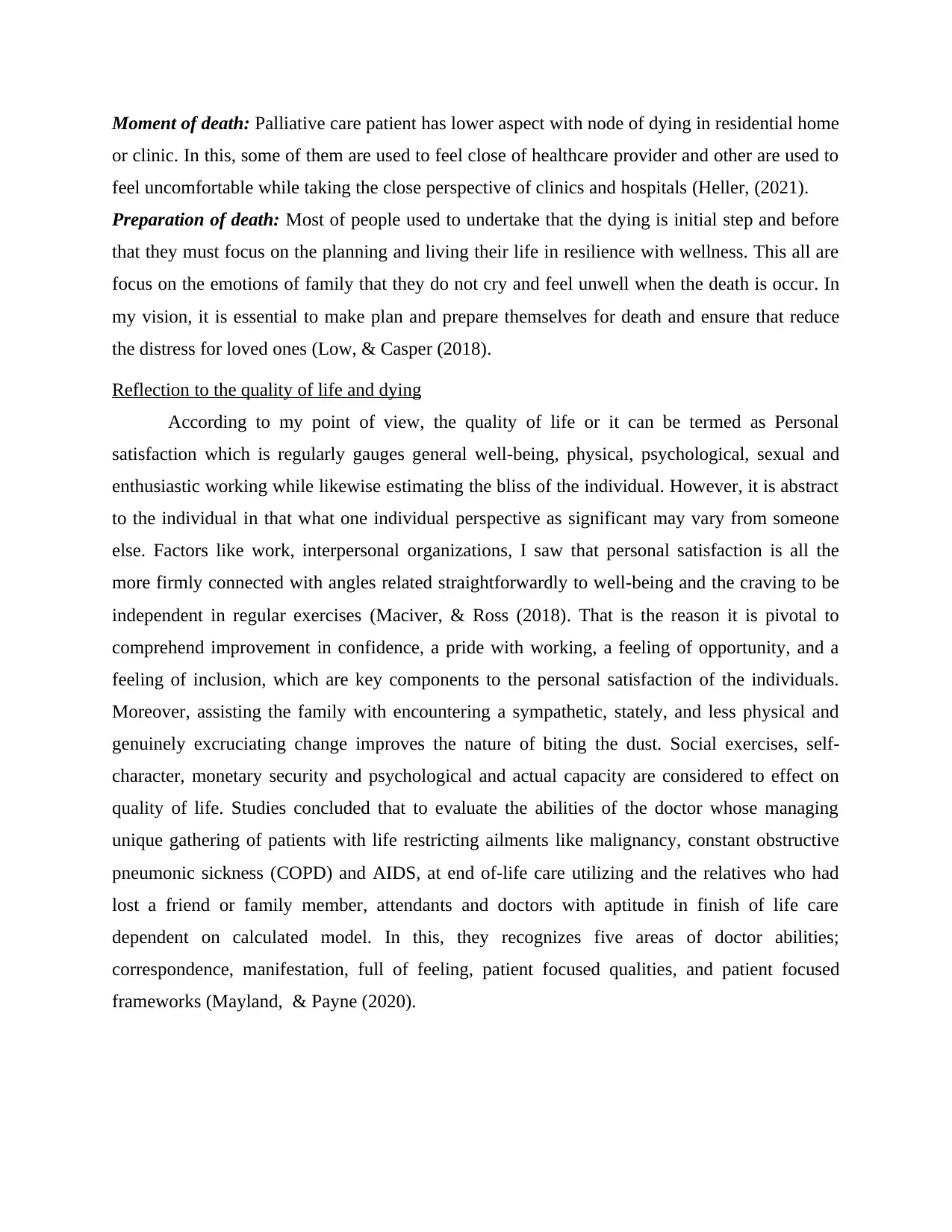
Moment of death: Palliative care patient has lower aspect with node of dying in residential home
or clinic. In this, some of them are used to feel close of healthcare provider and other are used to
feel uncomfortable while taking the close perspective of clinics and hospitals (Heller, (2021).
Preparation of death: Most of people used to undertake that the dying is initial step and before
that they must focus on the planning and living their life in resilience with wellness. This all are
focus on the emotions of family that they do not cry and feel unwell when the death is occur. In
my vision, it is essential to make plan and prepare themselves for death and ensure that reduce
the distress for loved ones (Low, & Casper (2018).
Reflection to the quality of life and dying
According to my point of view, the quality of life or it can be termed as Personal
satisfaction which is regularly gauges general well-being, physical, psychological, sexual and
enthusiastic working while likewise estimating the bliss of the individual. However, it is abstract
to the individual in that what one individual perspective as significant may vary from someone
else. Factors like work, interpersonal organizations, I saw that personal satisfaction is all the
more firmly connected with angles related straightforwardly to well-being and the craving to be
independent in regular exercises (Maciver, & Ross (2018). That is the reason it is pivotal to
comprehend improvement in confidence, a pride with working, a feeling of opportunity, and a
feeling of inclusion, which are key components to the personal satisfaction of the individuals.
Moreover, assisting the family with encountering a sympathetic, stately, and less physical and
genuinely excruciating change improves the nature of biting the dust. Social exercises, self-
character, monetary security and psychological and actual capacity are considered to effect on
quality of life. Studies concluded that to evaluate the abilities of the doctor whose managing
unique gathering of patients with life restricting ailments like malignancy, constant obstructive
pneumonic sickness (COPD) and AIDS, at end of-life care utilizing and the relatives who had
lost a friend or family member, attendants and doctors with aptitude in finish of life care
dependent on calculated model. In this, they recognizes five areas of doctor abilities;
correspondence, manifestation, full of feeling, patient focused qualities, and patient focused
frameworks (Mayland, & Payne (2020).
or clinic. In this, some of them are used to feel close of healthcare provider and other are used to
feel uncomfortable while taking the close perspective of clinics and hospitals (Heller, (2021).
Preparation of death: Most of people used to undertake that the dying is initial step and before
that they must focus on the planning and living their life in resilience with wellness. This all are
focus on the emotions of family that they do not cry and feel unwell when the death is occur. In
my vision, it is essential to make plan and prepare themselves for death and ensure that reduce
the distress for loved ones (Low, & Casper (2018).
Reflection to the quality of life and dying
According to my point of view, the quality of life or it can be termed as Personal
satisfaction which is regularly gauges general well-being, physical, psychological, sexual and
enthusiastic working while likewise estimating the bliss of the individual. However, it is abstract
to the individual in that what one individual perspective as significant may vary from someone
else. Factors like work, interpersonal organizations, I saw that personal satisfaction is all the
more firmly connected with angles related straightforwardly to well-being and the craving to be
independent in regular exercises (Maciver, & Ross (2018). That is the reason it is pivotal to
comprehend improvement in confidence, a pride with working, a feeling of opportunity, and a
feeling of inclusion, which are key components to the personal satisfaction of the individuals.
Moreover, assisting the family with encountering a sympathetic, stately, and less physical and
genuinely excruciating change improves the nature of biting the dust. Social exercises, self-
character, monetary security and psychological and actual capacity are considered to effect on
quality of life. Studies concluded that to evaluate the abilities of the doctor whose managing
unique gathering of patients with life restricting ailments like malignancy, constant obstructive
pneumonic sickness (COPD) and AIDS, at end of-life care utilizing and the relatives who had
lost a friend or family member, attendants and doctors with aptitude in finish of life care
dependent on calculated model. In this, they recognizes five areas of doctor abilities;
correspondence, manifestation, full of feeling, patient focused qualities, and patient focused
frameworks (Mayland, & Payne (2020).
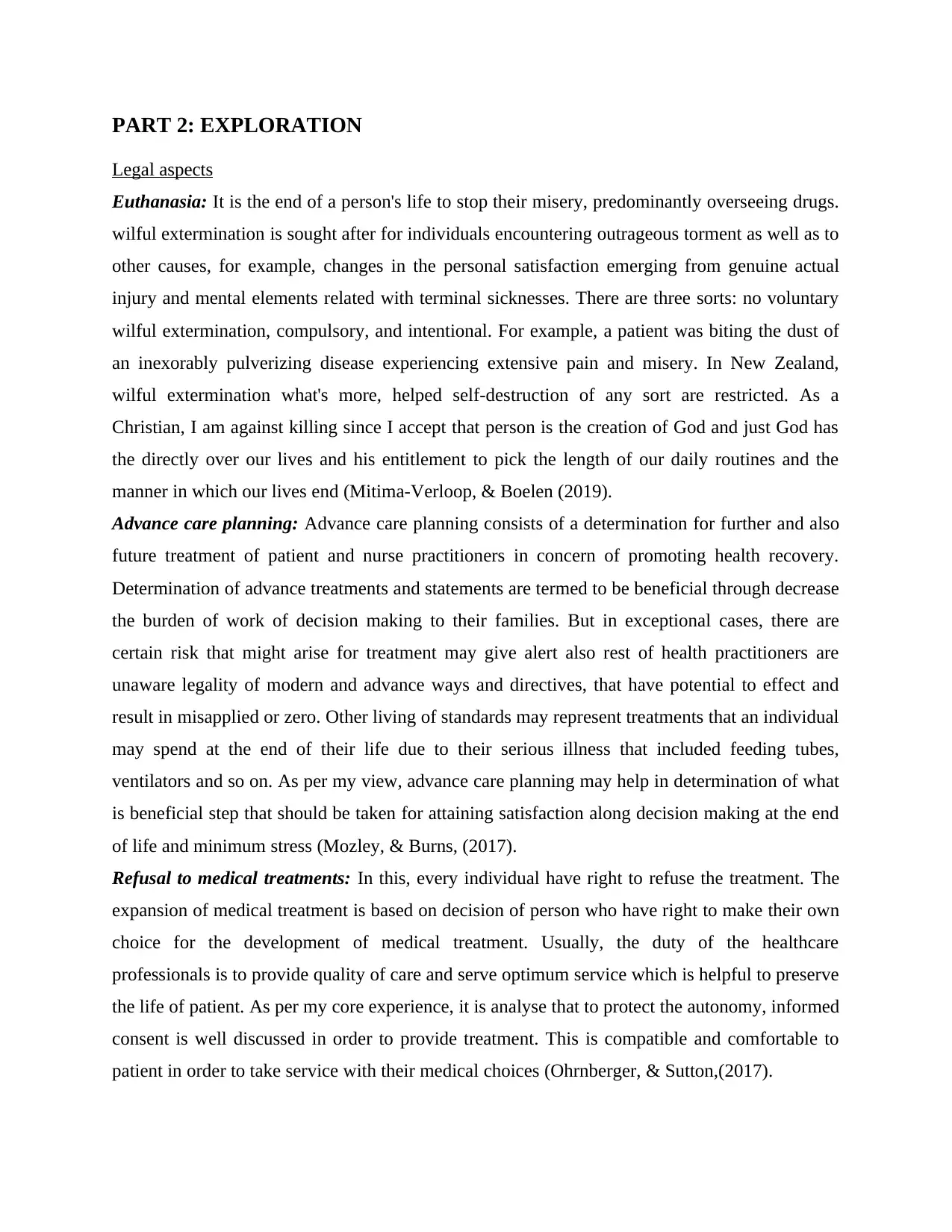
PART 2: EXPLORATION
Legal aspects
Euthanasia: It is the end of a person's life to stop their misery, predominantly overseeing drugs.
wilful extermination is sought after for individuals encountering outrageous torment as well as to
other causes, for example, changes in the personal satisfaction emerging from genuine actual
injury and mental elements related with terminal sicknesses. There are three sorts: no voluntary
wilful extermination, compulsory, and intentional. For example, a patient was biting the dust of
an inexorably pulverizing disease experiencing extensive pain and misery. In New Zealand,
wilful extermination what's more, helped self-destruction of any sort are restricted. As a
Christian, I am against killing since I accept that person is the creation of God and just God has
the directly over our lives and his entitlement to pick the length of our daily routines and the
manner in which our lives end (Mitima-Verloop, & Boelen (2019).
Advance care planning: Advance care planning consists of a determination for further and also
future treatment of patient and nurse practitioners in concern of promoting health recovery.
Determination of advance treatments and statements are termed to be beneficial through decrease
the burden of work of decision making to their families. But in exceptional cases, there are
certain risk that might arise for treatment may give alert also rest of health practitioners are
unaware legality of modern and advance ways and directives, that have potential to effect and
result in misapplied or zero. Other living of standards may represent treatments that an individual
may spend at the end of their life due to their serious illness that included feeding tubes,
ventilators and so on. As per my view, advance care planning may help in determination of what
is beneficial step that should be taken for attaining satisfaction along decision making at the end
of life and minimum stress (Mozley, & Burns, (2017).
Refusal to medical treatments: In this, every individual have right to refuse the treatment. The
expansion of medical treatment is based on decision of person who have right to make their own
choice for the development of medical treatment. Usually, the duty of the healthcare
professionals is to provide quality of care and serve optimum service which is helpful to preserve
the life of patient. As per my core experience, it is analyse that to protect the autonomy, informed
consent is well discussed in order to provide treatment. This is compatible and comfortable to
patient in order to take service with their medical choices (Ohrnberger, & Sutton,(2017).
Legal aspects
Euthanasia: It is the end of a person's life to stop their misery, predominantly overseeing drugs.
wilful extermination is sought after for individuals encountering outrageous torment as well as to
other causes, for example, changes in the personal satisfaction emerging from genuine actual
injury and mental elements related with terminal sicknesses. There are three sorts: no voluntary
wilful extermination, compulsory, and intentional. For example, a patient was biting the dust of
an inexorably pulverizing disease experiencing extensive pain and misery. In New Zealand,
wilful extermination what's more, helped self-destruction of any sort are restricted. As a
Christian, I am against killing since I accept that person is the creation of God and just God has
the directly over our lives and his entitlement to pick the length of our daily routines and the
manner in which our lives end (Mitima-Verloop, & Boelen (2019).
Advance care planning: Advance care planning consists of a determination for further and also
future treatment of patient and nurse practitioners in concern of promoting health recovery.
Determination of advance treatments and statements are termed to be beneficial through decrease
the burden of work of decision making to their families. But in exceptional cases, there are
certain risk that might arise for treatment may give alert also rest of health practitioners are
unaware legality of modern and advance ways and directives, that have potential to effect and
result in misapplied or zero. Other living of standards may represent treatments that an individual
may spend at the end of their life due to their serious illness that included feeding tubes,
ventilators and so on. As per my view, advance care planning may help in determination of what
is beneficial step that should be taken for attaining satisfaction along decision making at the end
of life and minimum stress (Mozley, & Burns, (2017).
Refusal to medical treatments: In this, every individual have right to refuse the treatment. The
expansion of medical treatment is based on decision of person who have right to make their own
choice for the development of medical treatment. Usually, the duty of the healthcare
professionals is to provide quality of care and serve optimum service which is helpful to preserve
the life of patient. As per my core experience, it is analyse that to protect the autonomy, informed
consent is well discussed in order to provide treatment. This is compatible and comfortable to
patient in order to take service with their medical choices (Ohrnberger, & Sutton,(2017).
⊘ This is a preview!⊘
Do you want full access?
Subscribe today to unlock all pages.

Trusted by 1+ million students worldwide

Cultural factors impacting the concept of living and dying
Arab culture: The Arab culture may represent enough involvement in the medical decision of an
individual. The head of the family may take final decisions on the medical treatments. On the off
chance that a patient has been determined to have a persistent condition, relatives may need to
shield the individual from the news. It is significant for care suppliers to know who should
contact the patient and family toward the begin to see how clinical subtleties ought to be
delivered and to whom. Protection and humility are imperative to ladies. For occasion, eye to eye
connection and physical between individuals of the other gender is an untouchable and ought to
consistently be disallowed (Talevi,& Pacitti (2020).
Philippine culture: Philippine culture refers as unequivocally ensure biting the dust relatives
from finding their visualization. For example, a few Filipinos may ask the family part not to
uncover that one is vanishing of worry for the sensation of misery of the individual and accepting
that solitary God will decide the destiny of the person (Powell, & Radbruch(2017).
Maori culture: Maori culture show their knowledge by handed down from the connection with
two broader community such as Whenua which is called as land and other one is Tupuna which
refers as ancestor. There are some of holistic approach which help to grace the desire of
individual on the basis of spirit which is shifted from the physical world to node of death which
act as realm on that moment. In my perspective, healthcare professionals are usually make proper
dealing with diverse culture in context of living and dying.
Religious approach to the concept of living and dying
Christianity: In the term of palliative care, the Christianity believes that the illness and death is
associated with the punishment and may encounter with the sense of guilt. Christian used to
provide some of teaching which state that death is an outcome of sin and a temporary
deallocation of soul and body (Pritchard, & Dray (2020).
Hinduism: They focus and believes in the aspect of karma, it defined with sense of principle of
cause and effect. Hindu used to provide teaching on death by stating that death is decided by one
fate and disease as the nature of one life.
Islam: Muslims used to focus and believe in paradise which is not considered as heaven. They
used to state that after the condition of death, soul lives. Death is punishment of Allah (God). As
per this, the Islamic community claim that the body dies and soul always lives and there is no
any hell and heaven (Ritchey, & Gruenewald. (2020).
Arab culture: The Arab culture may represent enough involvement in the medical decision of an
individual. The head of the family may take final decisions on the medical treatments. On the off
chance that a patient has been determined to have a persistent condition, relatives may need to
shield the individual from the news. It is significant for care suppliers to know who should
contact the patient and family toward the begin to see how clinical subtleties ought to be
delivered and to whom. Protection and humility are imperative to ladies. For occasion, eye to eye
connection and physical between individuals of the other gender is an untouchable and ought to
consistently be disallowed (Talevi,& Pacitti (2020).
Philippine culture: Philippine culture refers as unequivocally ensure biting the dust relatives
from finding their visualization. For example, a few Filipinos may ask the family part not to
uncover that one is vanishing of worry for the sensation of misery of the individual and accepting
that solitary God will decide the destiny of the person (Powell, & Radbruch(2017).
Maori culture: Maori culture show their knowledge by handed down from the connection with
two broader community such as Whenua which is called as land and other one is Tupuna which
refers as ancestor. There are some of holistic approach which help to grace the desire of
individual on the basis of spirit which is shifted from the physical world to node of death which
act as realm on that moment. In my perspective, healthcare professionals are usually make proper
dealing with diverse culture in context of living and dying.
Religious approach to the concept of living and dying
Christianity: In the term of palliative care, the Christianity believes that the illness and death is
associated with the punishment and may encounter with the sense of guilt. Christian used to
provide some of teaching which state that death is an outcome of sin and a temporary
deallocation of soul and body (Pritchard, & Dray (2020).
Hinduism: They focus and believes in the aspect of karma, it defined with sense of principle of
cause and effect. Hindu used to provide teaching on death by stating that death is decided by one
fate and disease as the nature of one life.
Islam: Muslims used to focus and believe in paradise which is not considered as heaven. They
used to state that after the condition of death, soul lives. Death is punishment of Allah (God). As
per this, the Islamic community claim that the body dies and soul always lives and there is no
any hell and heaven (Ritchey, & Gruenewald. (2020).
Paraphrase This Document
Need a fresh take? Get an instant paraphrase of this document with our AI Paraphraser
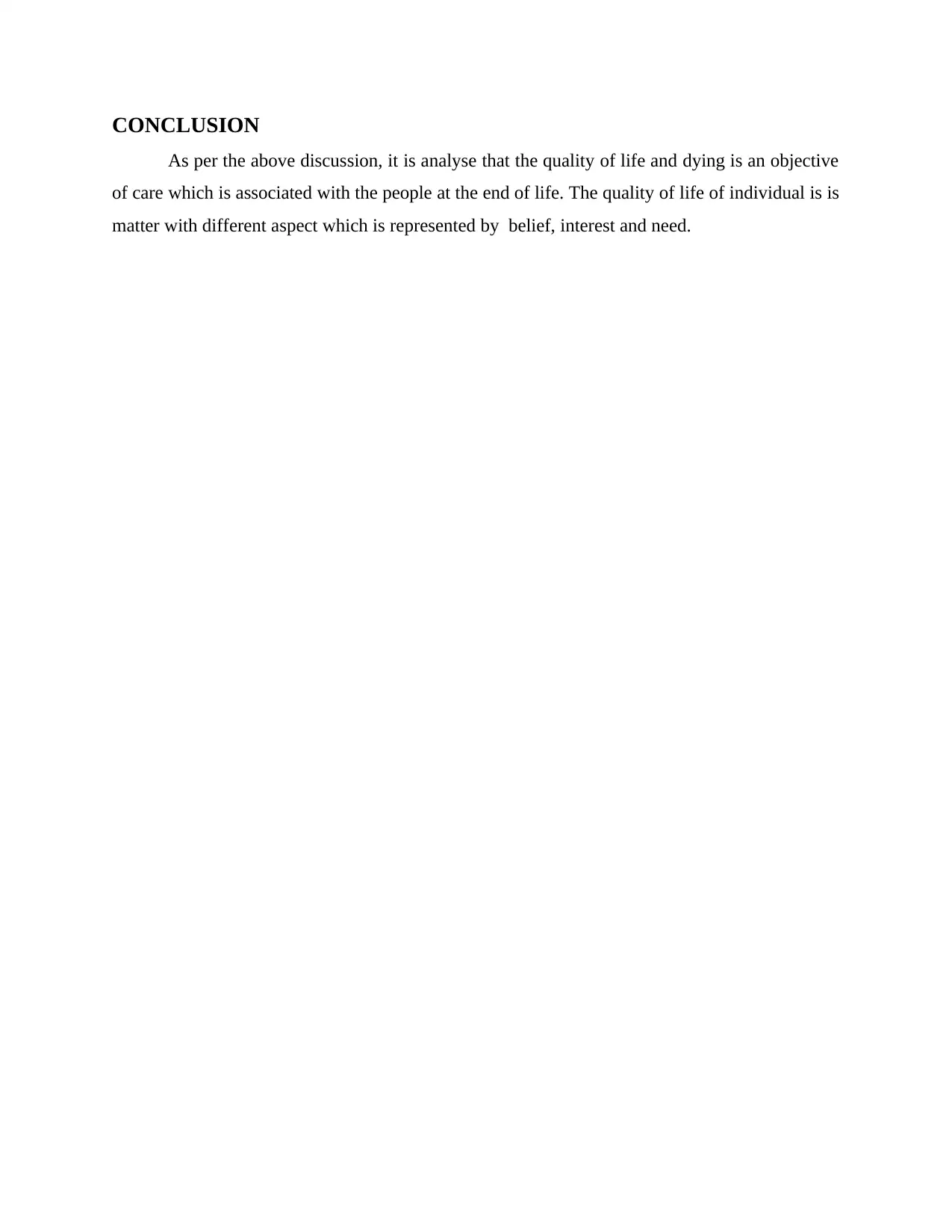
CONCLUSION
As per the above discussion, it is analyse that the quality of life and dying is an objective
of care which is associated with the people at the end of life. The quality of life of individual is is
matter with different aspect which is represented by belief, interest and need.
As per the above discussion, it is analyse that the quality of life and dying is an objective
of care which is associated with the people at the end of life. The quality of life of individual is is
matter with different aspect which is represented by belief, interest and need.
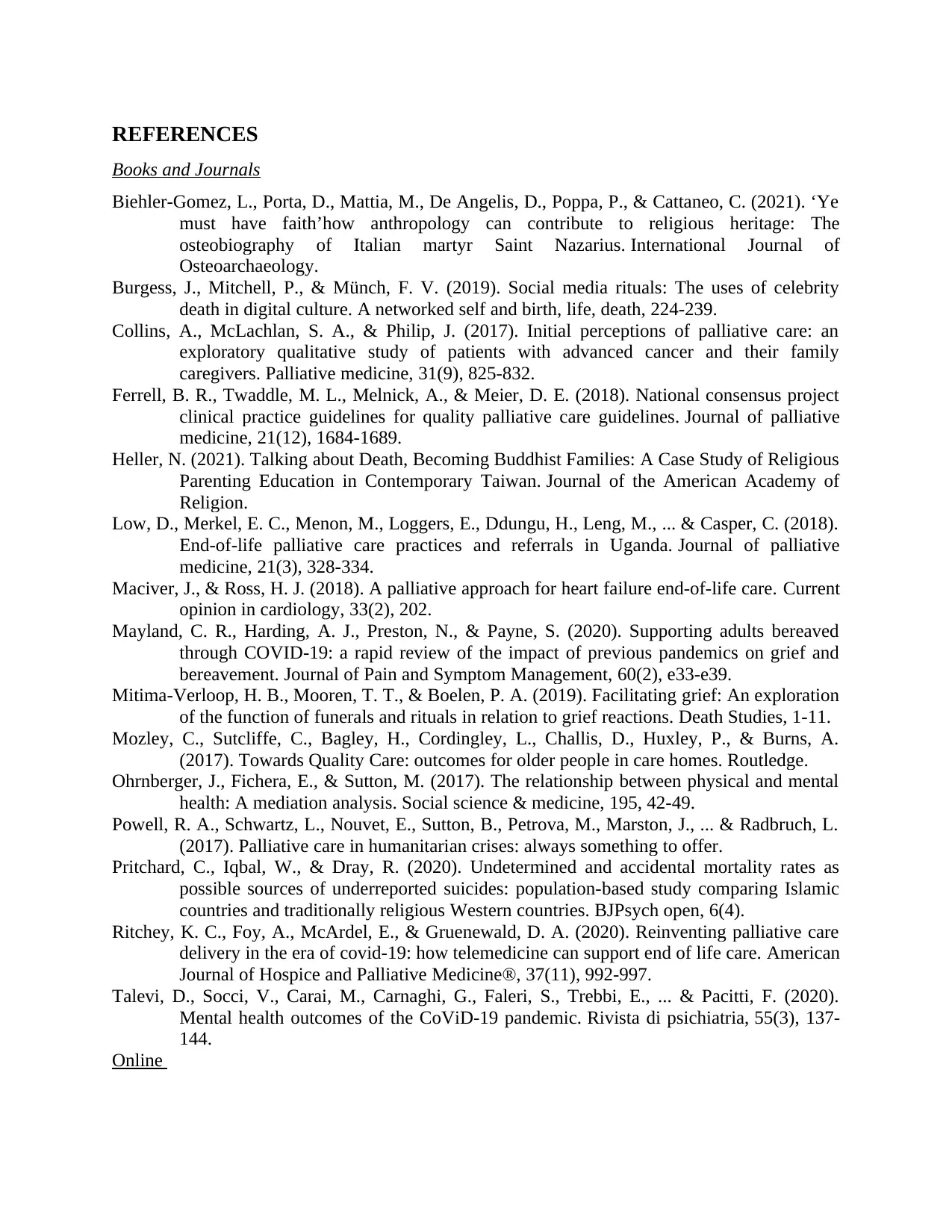
REFERENCES
Books and Journals
Biehler‐Gomez, L., Porta, D., Mattia, M., De Angelis, D., Poppa, P., & Cattaneo, C. (2021). ‘Ye
must have faith’how anthropology can contribute to religious heritage: The
osteobiography of Italian martyr Saint Nazarius. International Journal of
Osteoarchaeology.
Burgess, J., Mitchell, P., & Münch, F. V. (2019). Social media rituals: The uses of celebrity
death in digital culture. A networked self and birth, life, death, 224-239.
Collins, A., McLachlan, S. A., & Philip, J. (2017). Initial perceptions of palliative care: an
exploratory qualitative study of patients with advanced cancer and their family
caregivers. Palliative medicine, 31(9), 825-832.
Ferrell, B. R., Twaddle, M. L., Melnick, A., & Meier, D. E. (2018). National consensus project
clinical practice guidelines for quality palliative care guidelines. Journal of palliative
medicine, 21(12), 1684-1689.
Heller, N. (2021). Talking about Death, Becoming Buddhist Families: A Case Study of Religious
Parenting Education in Contemporary Taiwan. Journal of the American Academy of
Religion.
Low, D., Merkel, E. C., Menon, M., Loggers, E., Ddungu, H., Leng, M., ... & Casper, C. (2018).
End-of-life palliative care practices and referrals in Uganda. Journal of palliative
medicine, 21(3), 328-334.
Maciver, J., & Ross, H. J. (2018). A palliative approach for heart failure end-of-life care. Current
opinion in cardiology, 33(2), 202.
Mayland, C. R., Harding, A. J., Preston, N., & Payne, S. (2020). Supporting adults bereaved
through COVID-19: a rapid review of the impact of previous pandemics on grief and
bereavement. Journal of Pain and Symptom Management, 60(2), e33-e39.
Mitima-Verloop, H. B., Mooren, T. T., & Boelen, P. A. (2019). Facilitating grief: An exploration
of the function of funerals and rituals in relation to grief reactions. Death Studies, 1-11.
Mozley, C., Sutcliffe, C., Bagley, H., Cordingley, L., Challis, D., Huxley, P., & Burns, A.
(2017). Towards Quality Care: outcomes for older people in care homes. Routledge.
Ohrnberger, J., Fichera, E., & Sutton, M. (2017). The relationship between physical and mental
health: A mediation analysis. Social science & medicine, 195, 42-49.
Powell, R. A., Schwartz, L., Nouvet, E., Sutton, B., Petrova, M., Marston, J., ... & Radbruch, L.
(2017). Palliative care in humanitarian crises: always something to offer.
Pritchard, C., Iqbal, W., & Dray, R. (2020). Undetermined and accidental mortality rates as
possible sources of underreported suicides: population-based study comparing Islamic
countries and traditionally religious Western countries. BJPsych open, 6(4).
Ritchey, K. C., Foy, A., McArdel, E., & Gruenewald, D. A. (2020). Reinventing palliative care
delivery in the era of covid-19: how telemedicine can support end of life care. American
Journal of Hospice and Palliative Medicine®, 37(11), 992-997.
Talevi, D., Socci, V., Carai, M., Carnaghi, G., Faleri, S., Trebbi, E., ... & Pacitti, F. (2020).
Mental health outcomes of the CoViD-19 pandemic. Rivista di psichiatria, 55(3), 137-
144.
Online
Books and Journals
Biehler‐Gomez, L., Porta, D., Mattia, M., De Angelis, D., Poppa, P., & Cattaneo, C. (2021). ‘Ye
must have faith’how anthropology can contribute to religious heritage: The
osteobiography of Italian martyr Saint Nazarius. International Journal of
Osteoarchaeology.
Burgess, J., Mitchell, P., & Münch, F. V. (2019). Social media rituals: The uses of celebrity
death in digital culture. A networked self and birth, life, death, 224-239.
Collins, A., McLachlan, S. A., & Philip, J. (2017). Initial perceptions of palliative care: an
exploratory qualitative study of patients with advanced cancer and their family
caregivers. Palliative medicine, 31(9), 825-832.
Ferrell, B. R., Twaddle, M. L., Melnick, A., & Meier, D. E. (2018). National consensus project
clinical practice guidelines for quality palliative care guidelines. Journal of palliative
medicine, 21(12), 1684-1689.
Heller, N. (2021). Talking about Death, Becoming Buddhist Families: A Case Study of Religious
Parenting Education in Contemporary Taiwan. Journal of the American Academy of
Religion.
Low, D., Merkel, E. C., Menon, M., Loggers, E., Ddungu, H., Leng, M., ... & Casper, C. (2018).
End-of-life palliative care practices and referrals in Uganda. Journal of palliative
medicine, 21(3), 328-334.
Maciver, J., & Ross, H. J. (2018). A palliative approach for heart failure end-of-life care. Current
opinion in cardiology, 33(2), 202.
Mayland, C. R., Harding, A. J., Preston, N., & Payne, S. (2020). Supporting adults bereaved
through COVID-19: a rapid review of the impact of previous pandemics on grief and
bereavement. Journal of Pain and Symptom Management, 60(2), e33-e39.
Mitima-Verloop, H. B., Mooren, T. T., & Boelen, P. A. (2019). Facilitating grief: An exploration
of the function of funerals and rituals in relation to grief reactions. Death Studies, 1-11.
Mozley, C., Sutcliffe, C., Bagley, H., Cordingley, L., Challis, D., Huxley, P., & Burns, A.
(2017). Towards Quality Care: outcomes for older people in care homes. Routledge.
Ohrnberger, J., Fichera, E., & Sutton, M. (2017). The relationship between physical and mental
health: A mediation analysis. Social science & medicine, 195, 42-49.
Powell, R. A., Schwartz, L., Nouvet, E., Sutton, B., Petrova, M., Marston, J., ... & Radbruch, L.
(2017). Palliative care in humanitarian crises: always something to offer.
Pritchard, C., Iqbal, W., & Dray, R. (2020). Undetermined and accidental mortality rates as
possible sources of underreported suicides: population-based study comparing Islamic
countries and traditionally religious Western countries. BJPsych open, 6(4).
Ritchey, K. C., Foy, A., McArdel, E., & Gruenewald, D. A. (2020). Reinventing palliative care
delivery in the era of covid-19: how telemedicine can support end of life care. American
Journal of Hospice and Palliative Medicine®, 37(11), 992-997.
Talevi, D., Socci, V., Carai, M., Carnaghi, G., Faleri, S., Trebbi, E., ... & Pacitti, F. (2020).
Mental health outcomes of the CoViD-19 pandemic. Rivista di psichiatria, 55(3), 137-
144.
Online
⊘ This is a preview!⊘
Do you want full access?
Subscribe today to unlock all pages.

Trusted by 1+ million students worldwide

Palliative Care, 2020 [Online] Available through; <https://www.who.int/news-room/fact-
sheets/detail/palliative-care>
sheets/detail/palliative-care>
1 out of 10
Related Documents
Your All-in-One AI-Powered Toolkit for Academic Success.
+13062052269
info@desklib.com
Available 24*7 on WhatsApp / Email
![[object Object]](/_next/static/media/star-bottom.7253800d.svg)
Unlock your academic potential
Copyright © 2020–2025 A2Z Services. All Rights Reserved. Developed and managed by ZUCOL.




